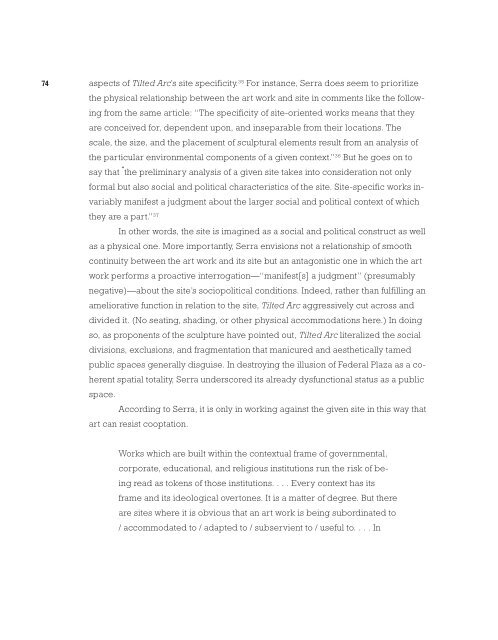ONE PLACE AFTER ANOTHER - Monoskop
ONE PLACE AFTER ANOTHER - Monoskop
ONE PLACE AFTER ANOTHER - Monoskop
You also want an ePaper? Increase the reach of your titles
YUMPU automatically turns print PDFs into web optimized ePapers that Google loves.
74<br />
aspects of Tilted Arc’s site specificity. 35 For instance, Serra does seem to prioritize<br />
the physical relationship between the art work and site in comments like the following<br />
from the same article: “The specificity of site-oriented works means that they<br />
are conceived for, dependent upon, and inseparable from their locations. The<br />
scale, the size, and the placement of sculptural elements result from an analysis of<br />
the particular environmental components of a given context.” 36 But he goes on to<br />
say that “ the preliminary analysis of a given site takes into consideration not only<br />
formal but also social and political characteristics of the site. Site-specific works invariably<br />
manifest a judgment about the larger social and political context of which<br />
they are a part.” 37<br />
In other words, the site is imagined as a social and political construct as well<br />
as a physical one. More importantly, Serra envisions not a relationship of smooth<br />
continuity between the art work and its site but an antagonistic one in which the art<br />
work performs a proactive interrogation—“manifest[s] a judgment” (presumably<br />
negative)—about the site’s sociopolitical conditions. Indeed, rather than fulfilling an<br />
ameliorative function in relation to the site, Tilted Arc aggressively cut across and<br />
divided it. (No seating, shading, or other physical accommodations here.) In doing<br />
so, as proponents of the sculpture have pointed out, Tilted Arc literalized the social<br />
divisions, exclusions, and fragmentation that manicured and aesthetically tamed<br />
public spaces generally disguise. In destroying the illusion of Federal Plaza as a coherent<br />
spatial totality, Serra underscored its already dysfunctional status as a public<br />
space.<br />
According to Serra, it is only in working against the given site in this way that<br />
art can resist cooptation.<br />
Works which are built within the contextual frame of governmental,<br />
corporate, educational, and religious institutions run the risk of being<br />
read as tokens of those institutions. ... Every context has its<br />
frame and its ideological overtones. It is a matter of degree. But there<br />
are sites where it is obvious that an art work is being subordinated to<br />
/ accommodated to / adapted to / subservient to / useful to. ... In

















